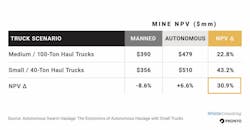Bigger is not better with autonomous haulers: study
Talk about counterintuitive: A recent study by Whittle Consulting and Pronto, an autonomy technology company that has designed an autonomous haulage system (AHS) for large mining trucks, has found that when haul trucks are automated, “bigger is no longer always better.”
Larger haul trucks mean more payload, but apparently a “swarm” of smaller automated trucks move faster and more efficiently for better value. And they don't clog the haul road.
"The industry has long debated whether mining economics shift to favor smaller trucks when autonomous," said Gerald Whittle, CEO, Whittle Consulting. "We're excited to publish the first rigorous analysis that demonstrates that for most mines, the answer is 'Yes.'"
Whittle and Pronto pitted 100-ton haulers against 40-ton haulers for the study, in both manned and autonomous tests.
Read also: Freeport-McMoRan mine to convert 33 trucks to autonomous
The study’s authors figured the net present value (NPV) of a copper ore mine through four different scenarios, considering all facets of the mining value chain over an 18-year life-of-mine horizon (see the chart above).
The study, called “Autonomous Swarm Haulage: The Economics of Autonomous Haulage with Small Trucks," had three primary findings.
First, the modeled mine operating with a fleet of autonomous 40-ton haul trucks would realize a 31% greater NPV than if the mine were operated with a fleet of manually driven 100-ton off-road haul trucks.
Autonomy significantly improved effective utilization by reducing truck downtime, standby, and operating delays to 5% of availability versus 20% for manual vehicles.
Finally, one anticipated flaw in the small truck logic was the prospect of traffic congestion caused by the increase in the number of trucks operating in the mine, potentially overcoming the efficiency gains of small trucks and automation. In the study's simulations, such traffic congestion did not materialize.
The study also concluded that converting an existing fleet of haul trucks to autonomous operations increased NPV irrespective of truck size. Both conclusions are consistent with industry experience and past studies, the authors said.
Komatsu, which has branded its AHS as “Frontrunner,” has had success selling the system to mines since going to market in 2008. Over 3 billion metric tons of material have been moved so far. Watch a video from the cab below:
The company offers (mechanical drive) haul trucks from 40 tons up to 153 tons, but it remains to be seen if it will be selling more of the 40-ton trucks in the future as part of swarms.
Pronto has just announced its partnership with RAICO S.A., a mining and forestry equipment sales and rental services provider in Chile, to scale mining and forestry autonomy in the country.
Under the agreement, RAICO will exclusively provide sales, distribution, installation, and aftermarket support services for Pronto AHS and Pollen Mobile private LTE / 5G network technologies in Chile. The partnership will initially be focused on deploying Pronto's OEM-agnostic AHS on Bell articulated dump trucks but will then expand to supporting other OEMs and applications.
About the Author
Frank Raczon
Raczon’s writing career spans nearly 25 years, including magazine publishing and public relations work with some of the industry’s major equipment manufacturers. He has won numerous awards in his career, including nods from the Construction Writers Association, the Association of Equipment Manufacturers, and BtoB magazine. He is responsible for the magazine's Buying Files.

